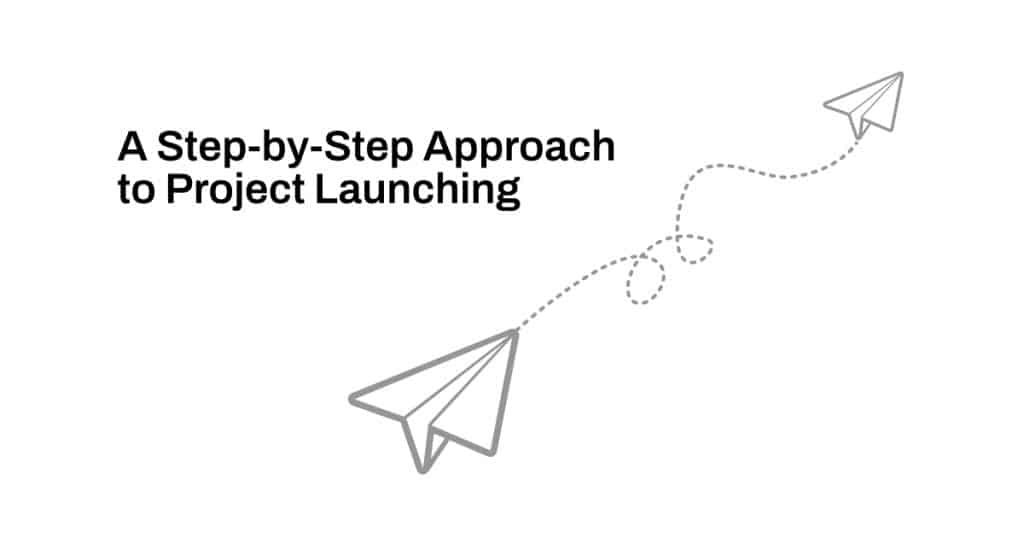Your cart is currently empty!
3. Turning Ideas into Real Projects
A Step-by-Step Approach to Project Launching
Q: What resources and planning do you need to start and launch a new project?
Defining your project goals and setting clear objectives are essential first steps in launching any project. This process ensures that the team is aligned and understands the project’s scope, purpose, and expected outcomes. When goals are well-defined and realistic, it becomes easier to create a roadmap and remain focused throughout the project’s duration.
To gain a thorough understanding of the project and its requirements, you need to ask yourself several key questions. These questions form the foundation of your project plan:
- What are we actually delivering? This refers to the project’s deliverables—the tangible or intangible outputs. These could range from a new product, service, or digital platform to a specific outcome, such as increased efficiency or enhanced customer engagement. Clearly defining what you’re delivering helps ensure the project stays on track and meets stakeholder expectations.
- What are our project objectives? Your objectives define the success of the project. These should be SMART objectives—Specific, Measurable, Achievable, Relevant, and Time-bound. For example, an objective might be to “increase website traffic by 20% in the next quarter” or “launch the new mobile app by the end of Q3.”
- Who are the key stakeholders, and how does the project affect them? Stakeholders include anyone with an interest or investment in the project, such as team members, clients, or external partners. Identifying key stakeholders early allows you to consider their needs, concerns, and contributions. Understanding how the project affects them can help tailor communication strategies and ensure smoother collaboration.
- What are the main stages and milestones in the project? Defining the project’s main stages breaks the work into manageable chunks. Each stage should have specific milestones—significant events or achievements that mark progress. For example, the stages might include planning, development, testing, and launch, with milestones such as “design approval” or “beta testing completion.”
- What resources do we need to begin? Resources encompass everything required to start and sustain the project, including human resources (team members), financial resources (budget), and physical or digital tools (software, equipment). By identifying the necessary resources early, you can mitigate the risk of delays due to underfunding or understaffing. Ensure that you allocate the right amount of time for each task, with flexibility for unforeseen challenges.
Answering these questions will provide clarity and aid in project planning, ultimately resulting in a well-informed project brief. This brief will serve as a blueprint throughout the project lifecycle, guiding both the team and stakeholders. A solid brief allows everyone to clearly understand the project’s scope, objectives, and deliverables, ensuring that expectations are aligned and realistic.

Using SMART Goal Settings in Project Management
Specific, Measurable, Achievable, Relevant, and Time-bound constitute the SMART goals framework, a structured approach that plays a crucial role in project management. Using SMART goals is important because it provides a clear, actionable path toward achieving your project objectives. Each component of the SMART framework ensures that the goals you set are clear, attainable, and aligned with the success of the project, preventing misunderstandings or unrealistic expectations.
- Specific: The goal should be clearly defined, leaving no room for ambiguity. A specific goal answers questions like “What needs to be accomplished?” and “Who is responsible?” For example, rather than setting a vague goal like “improve marketing,” a specific goal would be “increase email marketing sign-ups by 15%.”
- Measurable: Progress must be tracked, and success should be quantifiable. Measurable goals allow you to assess how far you’ve come and what remains. For instance, using metrics like “reduce customer complaints by 25%” makes it easier to evaluate your efforts.
- Achievable: Goals should be realistic and attainable within available resources and constraints. This prevents frustration and demotivation due to unattainable targets.
- Relevant: The goal must align with broader business objectives or the specific needs of the project. This ensures that the work being done contributes meaningfully to the project’s overall success.
- Time-bound: Every goal needs a deadline to create a sense of urgency and accountability. A time-bound goal might be “launch the new product by the end of Q2.”
Key Stages of Project Management
Setting SMART goals is just one part of the broader project management process, which can be broken down into five key stages:
- Initiation: This is where the project is defined at a high level. A feasibility study is often conducted to evaluate whether the project should move forward. Key stakeholders are identified, and the project’s purpose is outlined.
- Planning: This is where SMART goals are applied. A detailed project plan is developed, including the project’s scope, timeline, and budget. Tasks are broken down, and resources are allocated accordingly.
- Execution: The team begins to deliver the project during this phase. It’s essential to monitor progress closely to ensure everything stays on track with the initial plan.
- Monitoring and Controlling: While the project is being executed, continuous tracking against the SMART goals is necessary. Adjustments may be made to stay within scope, time, and budget constraints. Tools like Gantt charts and dashboards can help keep the team aligned.
- Closure: Once the project has met its goals, it is officially closed. This phase includes the delivery of final outcomes, project reports, and a reflection on what went well and what could be improved for future projects.
Identifying Project Stakeholders
Identifying stakeholders is crucial for project success. Stakeholders are individuals or groups who have a vested interest in the project’s outcome or can influence its execution. To identify stakeholders, consider the following:
- Who will benefit from the project?
- Who might be negatively impacted?
- Who has decision-making power or authority over the project?
- Who will be responsible for executing tasks?
Common stakeholders include the project sponsor, the project team, clients, suppliers, regulatory bodies, and internal or external entities. Understanding their needs helps ensure smoother communication and minimizes conflicts throughout the project lifecycle.
What is a Project Charter?
A Project Charter is a formal document that authorizes the start of a project. It provides an overview of the project’s scope, objectives, stakeholders, and roles, serving as a reference throughout the project’s lifecycle. A typical project charter includes:
- Project Purpose: Describes why the project is being undertaken and the problem it seeks to solve.
- Objectives: The SMART goals that the project will achieve.
- Stakeholders: Identifies the individuals involved, their roles, and responsibilities.
- Scope: Defines what will and will not be included in the project’s deliverables.
- Resources: A high-level outline of the budget, tools, and personnel required.
- Timeline: Provides an estimated project schedule.
The project charter helps prevent scope creep (the uncontrolled expansion of the project’s scope) and ensures that all parties have a clear understanding of the project before work begins. It also authorizes the project manager to use organizational resources for the project’s execution.
Suggestions and Definitions:
- Deliverables: The specific outcomes or products the project will create. Having clear deliverables helps ensure that the final output matches what was initially envisioned.
- SMART objectives: These provide a framework for setting clear, actionable goals. Make sure to elaborate on why each objective is necessary to keep the project on track.
- Key stakeholders: Individuals or groups directly impacted by the project’s outcome. Understanding their influence ensures that their needs are met, which helps avoid conflicts later on.

Project Launch Checklist
1. Define Project Goals
- ☐ Clearly state the project’s purpose
- ☐ Set SMART objectives (Specific, Measurable, Achievable, Relevant, Time-bound)
- ☐ Ensure goals align with broader business objectives
2. Identify Deliverables
- ☐ Define what the project will deliver (product, service, platform, outcome)
- ☐ Ensure deliverables meet stakeholder expectations
3. Identify Stakeholders
- ☐ List key stakeholders (team members, clients, partners)
- ☐ Determine how the project affects each stakeholder
- ☐ Create a communication plan for stakeholder engagement
4. Outline Key Stages & Milestones
- ☐ Break the project into stages (e.g., planning, development, testing, launch)
- ☐ Define clear milestones for each stage (e.g., design approval, beta testing completion)
- ☐ Assign responsibility for each milestone
5. Assess Resources
- ☐ Identify necessary human resources (team members, contractors)
- ☐ Allocate budget and financial resources
- ☐ List required tools and technology (software, equipment)
- ☐ Ensure time is allocated for each task, with flexibility for adjustments
6. Create a Project Plan
- ☐ Develop a detailed project roadmap
- ☐ Outline tasks, deadlines, and dependencies
- ☐ Assign team roles and responsibilities
- ☐ Set timelines for each stage
7. Draft a Project Charter
- ☐ Define the project’s purpose, objectives, and scope
- ☐ Identify stakeholders, their roles, and responsibilities
- ☐ Outline resources and budget requirements
- ☐ Create a high-level timeline
8. Risk Assessment & Mitigation
- ☐ Identify potential risks (financial, operational, market)
- ☐ Develop mitigation strategies for identified risks
9. Establish Communication Channels
- ☐ Set up regular meetings or status updates
- ☐ Determine tools for team collaboration (email, project management software)
- ☐ Assign responsibility for progress reports
10. Review and Finalize Plan
- ☐ Conduct a final review with the team and stakeholders
- ☐ Ensure all aspects are aligned before launch
- ☐ Get approval on the project charter
11. Begin Project Execution
- ☐ Launch the project according to the defined plan
- ☐ Monitor progress and adjust as necessary
- ☐ Keep stakeholders informed of milestones achieved
Use this checklist as a guide to ensure all critical elements are in place before launching your project.

